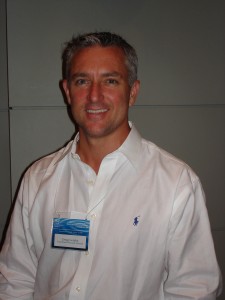Critical Mass is Critical – Creating Sustainable Scholarly Communication: The Session Blog
When: Friday, July 10, 2009 2pm – 3pm
Room: Main Concourse – Fletcher Challenge Room 1900
Presenter: Gregg Gordon
Gregg Gordon is President and CEO of the Social Science Research Network (SSRN). SSRN is a digital repository that has close to 100,000 full-text documents. The network allows readers access to full text and articles without any changes, but no access to the meta data attached to the articles. It has received approximately 30 million downloads so far. SSRN is part of the social networking community through a blog, Facebook, and Twitter.

Gregg Gordon (Source: Photo taken by Helen Szeto)
Session Overview:
Gordon’s presentation is about the growing amount of scholarly information that is out there and the connections that can be made with it. He starts off by defining the term “critical mass.” Critical mass is the minimum amount of something required to start or maintain a venture. Gordon believes that there is an endless abundance of information out there. There is a lot of research, but he asks the question, how can academics sort through everything? The biggest complaint received at the SSRN is that there is too much information with over 1000 journals available on the network.

(Source: slide courtesy of Gregg Gordon)
Gordon explains how the scholarship of information is growing. The Open Journal System (OJS) has enabled the creation of over 3000 OJS journals, which means over 3000 new publishers. Every 20 years, the amount of scholarly journals available is doubled. Ninety percent of all scientists are alive today, which means they are still making contributions to the scholarly world. The amount of research available increases because readers are getting access to earlier research stages. In the SSRN, 13% of the citations are towards working papers. Drafts are being referenced. Interdisciplinary classifications are also increasing research relevance. Academics are able to see the content from a broader amount of subjects.

(Source: slide courtesy of Gregg Gordon)

Gregg Gordon Presentation (Source: Photo taken by Helen Szeto)
Gordon says that traditional publishing models are slowing innovation. On the other hand, clusters of information are increasing innovation. Information is being connected to make more meaningful relationships. People are growing up with access to information and therefore understand that information needs to be free. Depositories are being built, but not used widely. Greg offers a formula to get people to the depositories. “C(onversation) + C(onnections) = C(ommunity)” Communities will form when people are talking about the information out there and making connections with the pieces. Gordon says as you find more content, you determine what is important to you. The community also has to provide many means to access the information. Content is being accessed through the web and various social networking sites. Wireless allows information to be accessible anywhere and everywhere.

Clusters and Connections of Relevant Information (Source: slide courtesy of Gregg Gordon)
In Gordon’s search trend analysis, he has discovered that people are looking at blogs and wikis to find what is important to them. Journal use has declined a little bit in trend. Gordon makes a reference to a NY Times article regarding Google search being replaced by YouTube in an elementary school.
The overall underlying message is that communities are key to sharing ideas and making relevant connections in your field of study.
Session Analysis:
Gordon makes good use of visual slides to display his ideas of growing information and the communities that emerge from the connections being made. By visually being able to see the clusters of information and the connections they form, we have a better understanding of their impact. Gordon has shown that repositories will be more efficiently used when the information is clustered and networks are created. We learn that communication is vital in grouping relevant research together. People need to have discussions and to share their ideas in the communities. Gordon is showing us how we can make better use of the information mass that is already out there.
Session Questions and Answers:
1) Why is there more structure in the scholarly publishing of hard sciences than in the social sciences?
Reply: Gordon compares scientific, technical and medical (STM) publishing and social sciences to a rifle shot and a shotgun approach. STM is like a rifle shot where information is very cloistered. “Social sciences have a shotgun approach because you want to get your information out there by getting published. In the hard sciences, you are writing to fund your lab, while in the social sciences; you are writing to build your lab.” There are two clear differences in submission approaches. “Some academics do not want to submit anything until it is it ready, while others will send out a proposal to put their stake out there.”
2) Gordon also comments that there needs to be a person checking the data to ensure that quality is there.
Related Links
- Social Science Research Network (SSRN)
- PKP 2007 – Creating Scholarly Communities and Fostering Innovation (presentation by Gregg Gordon)
- Critical Mass is Critical, Building Authority in a Changing World (under Feb 6, 2009 – video of G. Gordon’s presentation)
- Bepress: The Other Legal Repository
- An Interview with SSRN’s Gregg Gordon